The nuances of pruning gooseberries in the fall
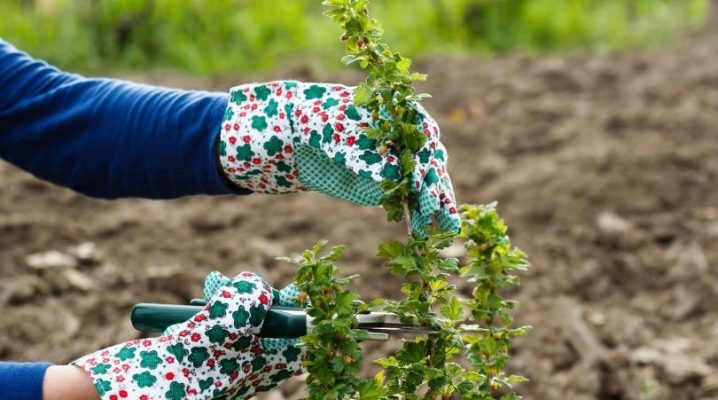
Pruning gooseberries in the fall is a must. It is carried out in order to subsequently get a good harvest. Gardeners who ignore this step risk lower yields with sour and small berries.

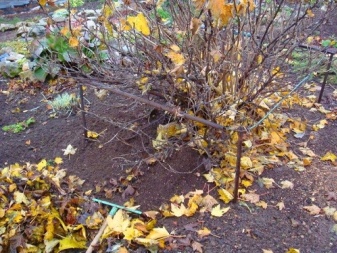
The need for a procedure
Many varieties of berry crops, including gooseberries, are prone to excessive shoot formation, which, growing over several years, can create a problem. This usually leads to a decrease in the yield of shrubs, a deterioration in the palatability of fruits, and a loss of varietal characteristics. The gooseberry is considered a light-loving plant, so it is important to provide it with plenty of light. Shoots grown nearby are able to shade the bushes, interfering with the uniform circulation of air masses inside the planting. This becomes the cause of the appearance of fungal and viral diseases. In addition, weakened bushes can act as easy prey for insects and other pests. In this case, from one bush, the gardener will be able to get very few fruits that have a hard skin and excessive acidity.
Autumn pruning of berry bushes is one of the most important activities for the gardener during this period. This is the most productive time for gardening. It is in the fall that the pruning of berry bushes and fruit trees should be carried out. At the same time, gardeners remove fallen leaves, broken branches, prepare a shelter for the winter. In addition to preparing the gooseberry for winter in the form of its dressing, it is necessary to trim the bushes. This work is mandatory, and it must be started even when the bush is very young, this will allow to correctly form the crown of the bush, protecting it from problems in future years.
The purpose of this circumcision is:
- removal of dry branches and damaged or diseased shoots;
- pruning old branches that do not bear fruit;
- cutting off shoots that interfere with each other, because this leads to improved access to fresh air for planting;
- correct formation of the bush, its crown.
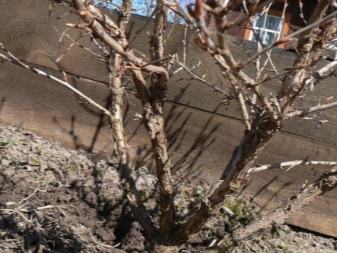
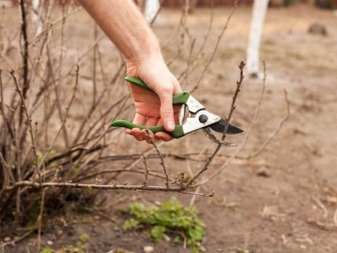
With proper care and regular pruning, growers can look forward to increasing yields and extending the productive age of the crop. In order to avoid mistakes when pruning gooseberries, it is better to listen to the advice and recommendations of experts.
- In the event that the bush is overgrown, do not delay pruning. In this case, the plant simply will not give a crop, or there will be many small and drooping fruits on the intertwined branches.
- When cutting branches, they do it at an angle. If cut straight, young branches will grow inward, which will negatively affect yield.
- Excessive pruning is undesirable in the first two years.... It is enough to shorten the newly emerged shoot by half.
- It is necessary to regularly check the plantation and make sure that the cuttings do not take root unauthorizedly. In this case, the mother bush will be depleted, which again will negatively affect the yield.
- During one season, you should not cut more than a third of the branches, with a more radical haircut, you can harm the perennial.
- In case of a small harvest, it is recommended to cut the stem to the lateral branch with young sprouts.
When carrying out garden work on the site, it is imperative to collect dry and cut branches, this will help reduce the risk of fungal diseases.
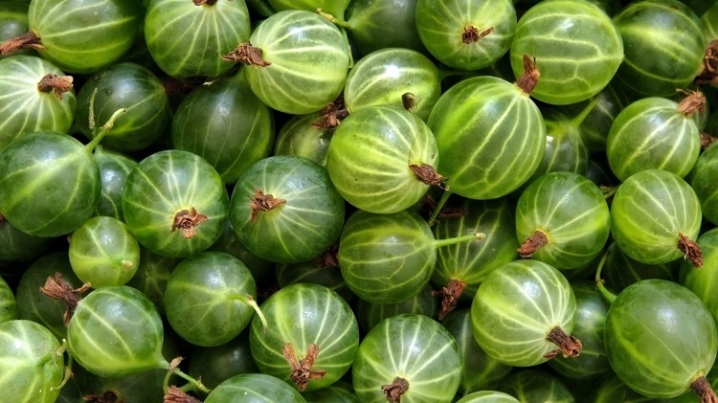
What tools to prepare?
Gardening work is difficult without special tools. Because of the thorns that gooseberries have, when cutting the bush, it is advisable to have tight gloves that can protect your hands from scratching. You should also prepare clothing that covers exposed areas of the body. In addition, such tools will come in handy in the work.
- Secateurs... It is used to remove the tops from young plants.
- Lopper... A tool for working with branches of medium thickness is suitable. It is also chosen when regulating thickened old plantings.
- Saw... Choose a saw for removing hard knots and shoots.
You also need to stock up on disinfectants and healing agents necessary for processing the sections. Not all tools may be needed in the work, given the age of the plants and the season. So, for processing a young bush, one pruner is needed. When choosing a secateurs, you should pay attention to tools that have one or two-sided sharpening. In order for the stems to cut and not break, it is important that the blades are well sharpened. After use, garden tools must be sterilized. Quality and ease of use are important criteria when choosing them.
An important factor is the presence of comfortable rubberized handles in the tools. Choosing a good fixture will eliminate the need to update it and buy a new one.



Views
It is possible to distinguish certain types of gooseberry cuttings with different schemes and methods of removing branches. These include formative pruning, thinning, sanitary, and rejuvenating.
- Formative... Formative pruning is used on shrubs from a year to 5 years. Timely formation will allow you to get a full-fledged bush in the future. Usually, this type of pruning is carried out, combining it with sanitization.
- Thinning... Thinning or lightening trims are used for crops that have reached the age of 5 to 10 years. During this period, the gooseberry bushes are already fully formed and are actively bearing fruit. To maintain the yield at the proper level and to obtain useful berries that are distinguished by high taste characteristics and presentation, interfering shoots are removed, creeping along the ground or growing inside the bush. Perform similar work after carrying out sanitary pruning.
- Sanitary... With sanitary pruning, diseased branches, shoots that have been damaged by pests, and dried twigs are removed from the bushes. Such manipulations can be carried out in the summer, if necessary, but the autumn period is considered the optimal time for sanitary work. This is done only after harvesting the fruits.
- Rejuvenating... Anti-aging activities are carried out for bushes that are starting to age. For crops that bear fruit for more than 10-12 years, yield begins to decline sharply.
Considering that gooseberries bear fruit on average up to 25 years, it is recommended to carry out anti-aging cleaning of the bushes. To do this, gardeners remove shoots to stimulate the plant to form new shoots.
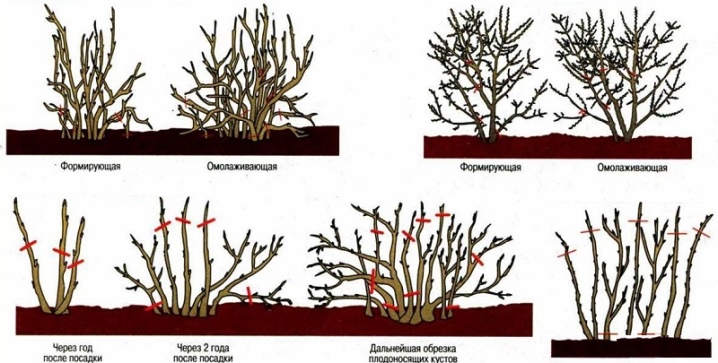
How to prune bushes correctly?
Expert advice will help you to properly cut old branches, trim the bush and prepare the plant for winter. They will help both for novice summer residents and for more experienced gardeners. The timing of garden maintenance work may shift depending on temperature changes, the presence of rain and other factors. On average, in the Moscow region, bushes are cut in October. The main thing is to do the work before frost and cold weather appear, that is, before the end of October or the beginning of November. Preparation for pruning bushes occurs in a certain way. Given the different ages of the plants, they need to be cut in a special way.
There is a scheme that allows you to carry out such work.
- They begin work in the garden by removing dried, diseased or simply damaged shoots. It is necessary to do this carefully, without leaving stumps, cutting out branches at the very root.Do this with shoots that have reached 5 years of age. The most fruitful branches are those that have reached 2 or more years. They differ in bark. Young shoots have a smooth green bark, in older branches it is already more rough, has a gray or gray-brown tint.
- It is advisable to also remove the branches located below, since they are more often the cause of the spread of diseases due to insufficient sunlight.
- It is necessary to remove branches growing inwardthickening the crown or interfering with each other.
- After that, you need to examine the shoots of this year and choose a few of the strongest ones, cutting them off over a large bud. The rest of the growth is cut off completely.
Autumn pruning allows you to remove at least 30% of the growth. Sometimes you have to cut up to 70% if the condition of the bush requires it. According to experienced specialists, at least 18-20 shoots should be left, the age of which is 1-5 years, and up to five branches of this year.
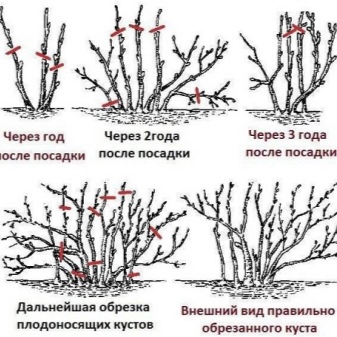

Young
Timely work done on the site will allow you to get well-formed bushes that give a full harvest... For young plantations, shaping pruning is carried out. It is carried out in the early years. This will allow the shrub to form a good crown, which will greatly facilitate the care of the crop in subsequent years. The gooseberries planted in the current year must be pruned. For this, the tops of the shoots are pruned into 2 or 3 buds. It also removes damaged branches or broken shoots.
In the 2nd year, it is necessary to decide on the strongest shoots, they will later become the basis for the shrub, its skeleton. They need to be shortened. The cut is made 1-2 cm above the selected kidney, while it should be directed outward. Work in the third and fourth year of plant life is similar to pruning in previous years. The gardener needs to remove the young growth at the root and shorten the top of the shoots selected by the main ones by a third.
It is also necessary to check for rotten or diseased branches and remove them if necessary.
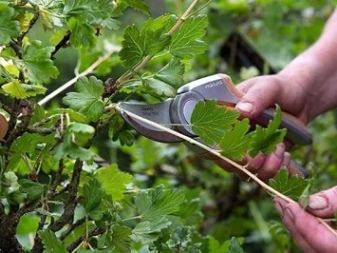

Adults
After 5 years, the bush is already considered formed. The plant in this period needs clarifying and sanitary pruning. Such manipulations are carried out for a long time. With proper care, the plant will continue to fully bear fruit for up to 10-12 years. Adult plants should have about 20-22 fruiting branches. During this period, it is necessary to rejuvenate the bush, gradually removing old shoots.
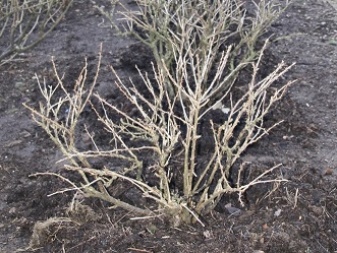

Old
After 10 or more years, the yield of the berry crop begins to gradually decline. Gooseberry berries begin to become smaller and smaller, their taste deteriorates... All these factors affect the life of the bush. As a result, it is necessary to carry out anti-aging pruning with the removal of previously fruiting shoots.
Often, gardeners, trying to rejuvenate the gooseberry, completely remove the shoots by cutting them out at the root. You should know that after such actions, it will take more than one year to restore the bush, and you can get the first harvest after 2 or 3 years. At the same time, it is unlikely that it will be possible to achieve the desired result in the form of the usual harvest. In addition, there is a high probability that the plant may die. It is much easier to take and cut the shanks, using them for reproduction, or to plant a bush.
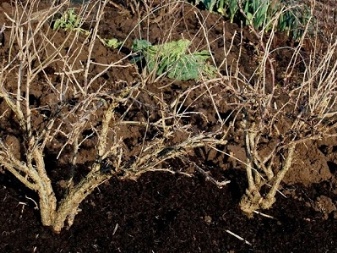

Follow-up care
Top dressing is essential for the normal functioning and growth of plants. But even with proper pruning, gooseberry bushes are stressed, so it is important to take care of them after each procedure. It is also important to process them. To do this, use urea in solution, garden pitch or crushed activated carbon. After removing old branches and processing, the plants must be fed. Experienced gardeners recommend using a mixture of humus, superphosphate and potassium as fertilizer.
It is advisable to spray weakened plants with Bordeaux mixture... Such a manipulation will protect the bushes from the invasion of pests. Fungicide products will also help in this. The most effective options are drugs Teldor, Infinito, Coronet and others. It is recommended to spray with preparations not only the bush, but also the soil around it.
Having cut the gooseberries, it is recommended to feed the bushes with fertilizers with potassium and phosphorus. The earth must be dug up. It is important not to harm the roots. Between the rows, the earth is dug on a bayonet, and under the bush - by 5-6 cm. It is necessary to treat the surface with fungicides, use it as insulation for the roots and when preparing the plantation for the cold, leaf compost, mulch or peat.
Before frosts, it is better to shed perennial shrubs, adding up to 20 liters of water under each specimen. Such watering will significantly increase the resistance of the roots to cold snap and frost.

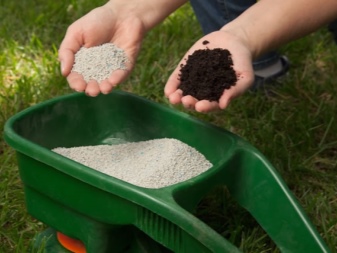
Although the gooseberry is considered an unpretentious plant, do not underestimate the activities carried out in the form of pruning, harvesting old branches, fertilization. It is necessary to monitor the crown, remove dry branches and diseased shoots in time, observe preventive measures. The yield of perennials will directly depend on compliance with these requirements.
Often, novice gardeners, growing gooseberries, make mistakes.
- Poor harvests are often caused by untimely pruning of the bush... In the spring, the gooseberries are cut only before the buds appear, while in the fall they do not do this after the onset of cold weather, frost.
- Removing tree branches with the emerging young shoots will lead to a decrease in fruiting.
- Untimely fight against diseases, insect pests, powdery mildew. Falling leaves indicate the appearance of powdery mildew. When inspecting the inside of the leaflet, a harmful moth butterfly is found. It is necessary to immediately treat such a bush.
The formation of a perennial is a mandatory procedure. The main rule in this case is the presence of fruitful shoots of different ages on the bushes, on which the crop will ripen. These and other factors should be considered when planting this crop.
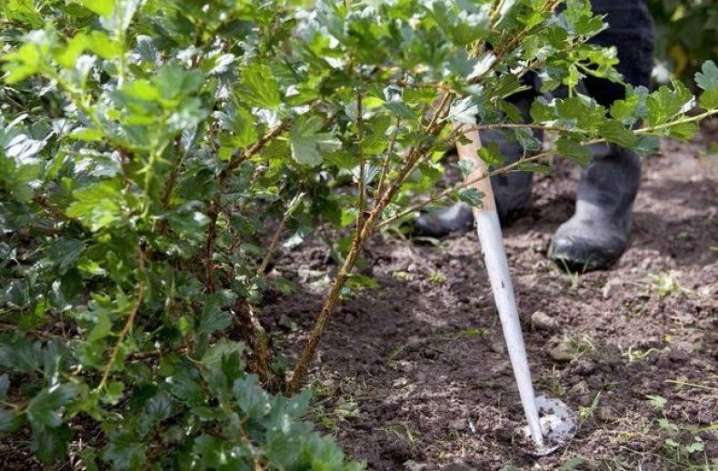













The comment was sent successfully.